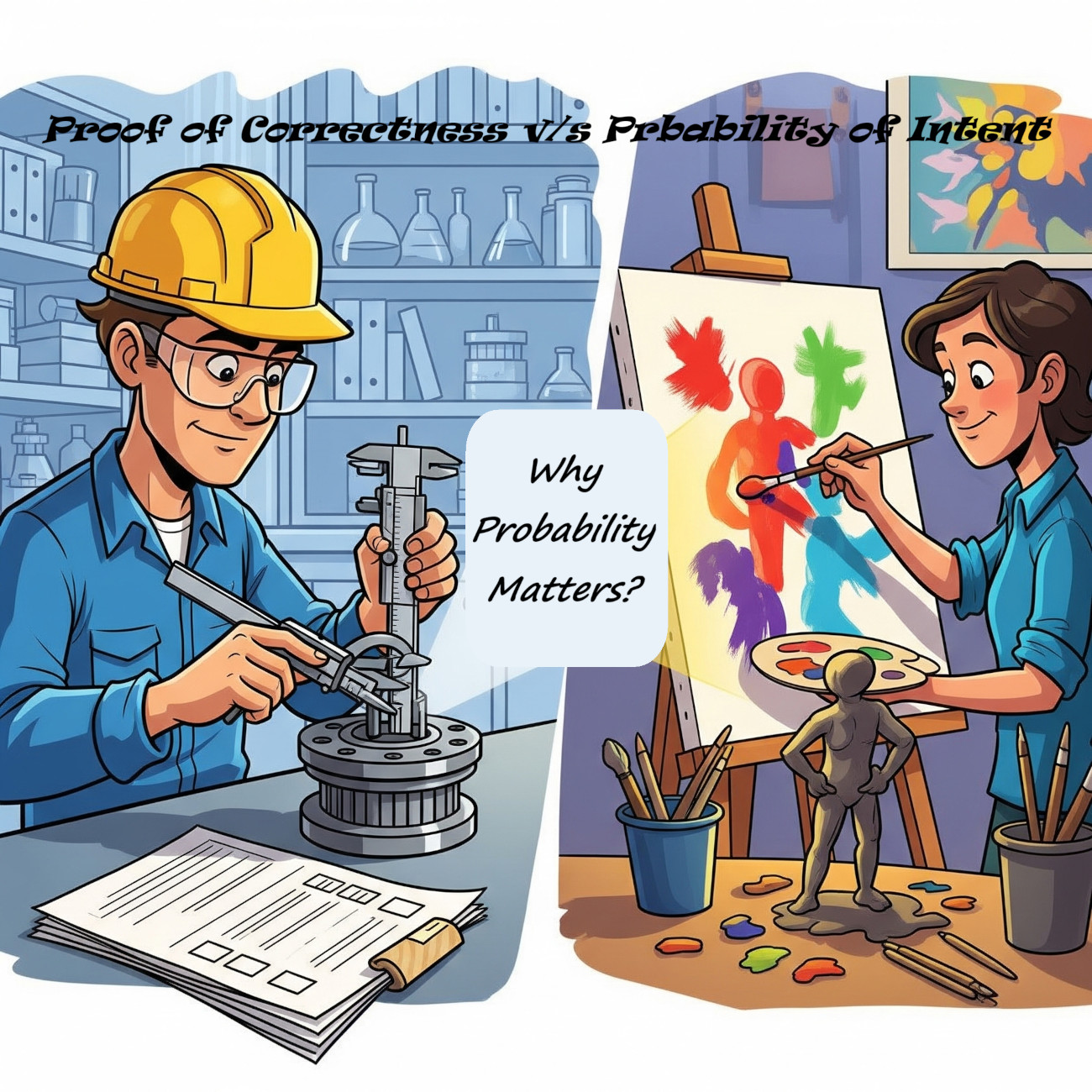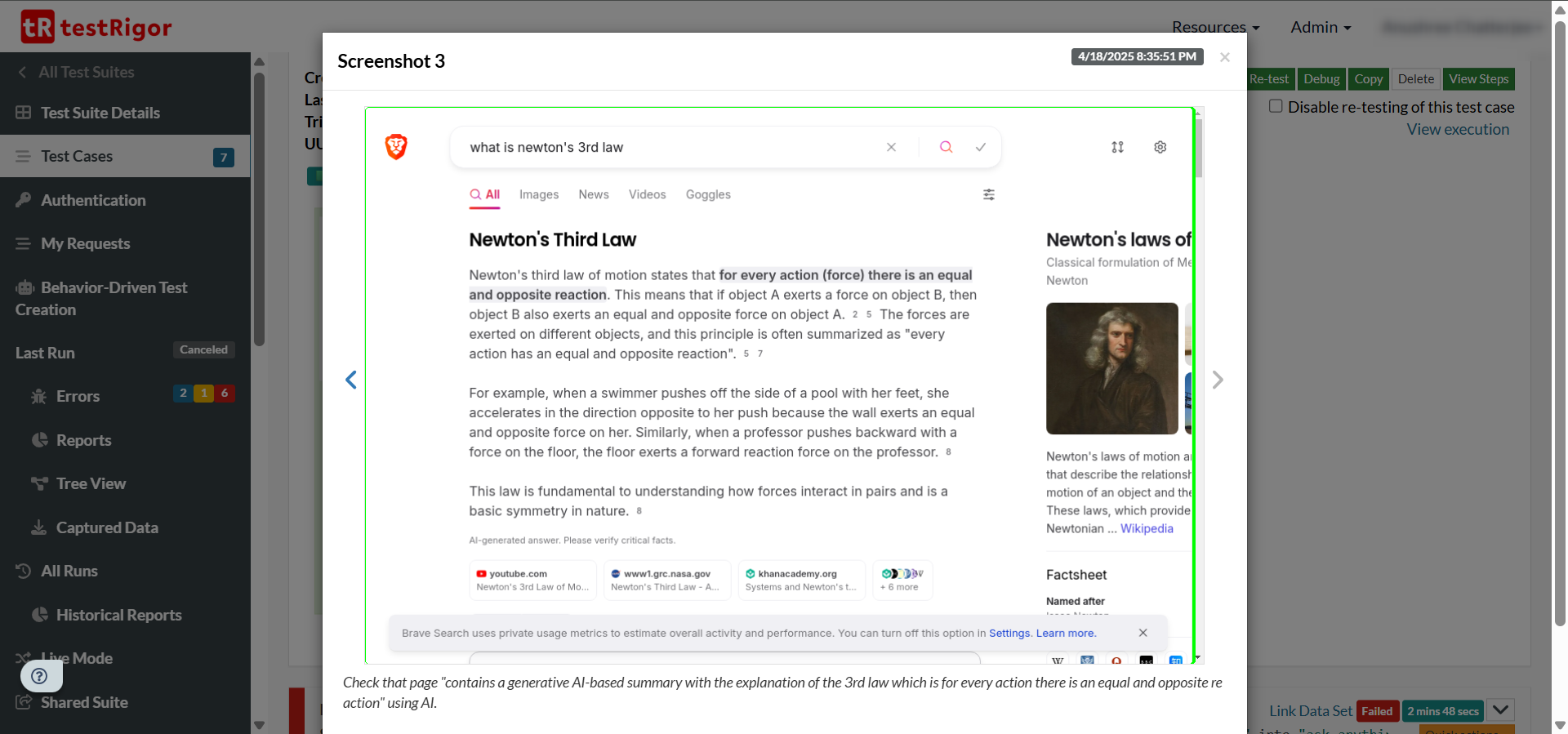Generative AI vs. Deterministic Testing: Why Predictability Matters
|
|
“Generative AI adoption has surged across industries, with the technology sector leading the charge at an impressive 88 percent usage rate across functions in 2024.”
Those who have used generative AI will find it pretty impressive. When it comes to software testing, generative AI can still be quite helpful – it can create test cases for you, fix your broken test cases, and even give intelligent insights for your test runs. Yet, one may find it unreliable, simply because it doesn’t give the same answer twice.
On the other hand, with deterministic approaches, you are certain about the outcome, which in turn gives a sense of satisfaction because it isn’t as abstract as working with generative AI.
Key Takeaways
- Deterministic systems yield consistent, expected results for a given input. This predictability is vital for validating behavior, debugging effectively, and ensuring reliability.
- Domains like aerospace, automotive, finance, and healthcare rely on predictable software. A small deviation in these environments can lead to catastrophic consequences or financial losses.
- Generative AI produces creative and unique outputs by design. It is valuable in many ways, but its non-deterministic nature poses challenges for consistent testing.
- Unpredictability can lead to disaster in high-stakes environments. Determinism allows better risk modeling, mitigation planning, and safety validation. We need new frameworks that accommodate AI’s strengths while preserving software reliability.
So, should we steer clear of generative AI? Why is predictability so important in software testing? Let’s answer these questions below.

What is Deterministic Testing?
Imagine going to purchase a gadget. You read the label, and it tells you what the product inside is meant to do. You bring it home, try it out, and it does exactly what you read on the label. That’s the dream of every developer and tester.
Predictability is inherent to software development. All those test cases that you write test against an expectation. This ability to determine what the system will do next is a cornerstone of quality assurance. If you consistently input ‘2 + 2’, you always expect to get ‘4’. You wouldn’t want it sometimes to give you ‘3.9’ or ‘5’. That’s determinism in action.
Here’s what defines it:
- Known Outputs for Known Inputs: This is the golden rule. A deterministic system yields the exact same output for a given set of inputs. No randomness, no “maybe,” no “it depends”. If you do X, you will always be guaranteed Y.
- Repeatability and Reproducibility: Since the input will always give the same output, you can execute an entire test scenario a thousand times and get a thousand identical results. This means that it is very straightforward to check whether a change has broken something or a bug has actually been fixed. In case a bug does show up, you have a consistent way to reproduce it, and that is the starting point for fixing it.
- Clear Test Cases and Expected Outcomes: Before you even run a deterministic test, you know exactly what you’re looking for. You define a specific input, and you define the precise output you expect. This clarity leaves no room for ambiguity. It’s like having a detailed instruction manual for what the software should do under every specific condition.
Why Does Predictability Matter?
The inherent predictability of deterministic testing isn’t just an academic concept; it translates into significant, tangible benefits for users and developers alike:
- Reliability and Stability Assurance: When software behaves predictably, it’s reliable. You can depend on it to perform its intended function consistently. This is paramount for any application, from your banking app to the operating system on your computer. It means fewer crashes, fewer unexpected errors, and a smoother user experience.
- Ease of Debugging and Fault Isolation: Picture that you have to fix a fault in a system that gives you a different behaviour every time you run it. It would be a nightmare! More debugging magic comes your way because of deterministic testing. When you fail a test, you know precisely what input caused the failure, and simply that the output was not as expected. This helps developers to quickly locate the buggy code, extend the issue, and patch it up.
- Compliance with Regulatory Standards: There are a lot of industries that are often highly regulated, especially those dealing with public safety or financial security. Consider devices like medical devices, financial trading platforms, or even the machines we use to vote. These systems usually need to ensure their reliability and consistency. Due to such strict regulatory and compliance requirements, regulatory authorities require verifiable evidence, which deterministic testing can provide.
- Performance Guarantees: It’s not just functionality that deterministic testing helps with. Performance is also something that you can easily check. For example, you can always measure the duration of a process, how much memory it is consuming, or how many transactions it processes per second. This enables developers to optimize code and ensure the software meets targeted performance metrics.
Real-World Examples of Deterministic Testing
There are certain domains where a lack of it would be a disaster. This is where predictability goes from being nice-to-have to must-have.
- Safety-Critical Systems (Automotive, Aerospace, Medical Devices): This is arguably the most straightforward and important use case.
- Automotive: Your car’s anti-lock braking system must engage and function precisely how it was designed to, every single time in all conditions. This is not a “once in while, it brakes” situation.
- Aerospace: Flight control systems, navigation, and engine management must function absolutely reliably and precisely. A bug could be a catastrophe.
- Medical Devices: Medical devices, such as insulin pumps and pacemakers, and surgical robots, should always dispense exact doses and perform actions as intended without fail. Their predictable function, of course, is a matter of human life.
- Financial Transactions and Banking Systems: When moving money, making a bill payment, or trading stocks, you want your transaction to be processed accurately, and there is no way to reverse it. The whole financial system depends on very deterministic processes where every penny has to be accounted for to avoid errors, fraud, and financial tumult.
- Infrastructure and Utilities: Software that runs power grids, water treatment plants, or communication networks needs to be highly predictable and resilient by design. If these systems fail, they can disrupt many things and cause harm.
- Core Software Libraries and Operating Systems: The fundamental building blocks of nearly all other software, such as the core functions that exist within an operating system (for example, how your computer manages files, memory, or network connections) or libraries used by many other programs, need to be deterministic. If these core elements misbehave, it will shake the foundation of everything built on top of it.
The Rise of Generative AI
Generative AI is about creation, not like traditional software, which has one answer that it is geared towards giving you. It is configured to generate original material from scratch, often in a manner that feels distinctly human.
Here’s what it does differently:
- It Can Produce New, Unique Outputs: Instead of only analyzing existing data or adhering to inflexible parameters, generative AI can compose truly novel text, images, music, code, and even data! Juxtapose this to a calculator; an AI is not a calculator, it is a creative engine.
- Fundamental Models (LLMs, GANs, etc.): This amazing ability is understood as a property of complex mathematical models. You may have come across terminologies like “Large Language Models” (LLMs) that are used to power website that writes essays or code, and “Generative Adversarial Network” (GAN) that can generate super-realistic but fake images. These models are designed to work with very large data sets, allowing them to learn the patterns and structures in the data and use this knowledge to create realistic new content.
- Probabilistic and Non-Deterministic Nature: Generative AI’s outputs are often probabilistic because it is designed to be creative and adaptable. That means that providing the same input twice may generate different results, even though both might be correct. Similar to asking a person to draw a tree – they’re not going to draw the same tree over and over again, but it will be a tree each time, recognizably unique to having been crafted by a single hand. Thus, this creativity is largely due to this quality of being “non-deterministic”, and this introduces interesting challenges when you try to test it.
Why Predictability Matters
It is easy to get swept up in the excitement of generative AI, its ability to “think”. But beneath the surface, a fundamental truth persists: for many applications, particularly those we rely on daily for safety, finance, and basic functionality, predictability isn’t just a preference; it’s an absolute necessity. It’s about having control, understanding outcomes, and being able to trust the technology. Predictability is important for
Reliability and Trust
Imagine if your car sometimes decided to brake on its own, or your banking app occasionally showed the wrong balance. You wouldn’t trust it, right? Predictability builds that trust.
- The Need for Consistent and Expected Behavior in Critical Applications: For systems that directly impact lives, livelihoods, or essential services, consistent performance is non-negotiable. When you press a button on a medical device, you expect a precise, predictable action. When you execute a trade on the stock market, you expect the order to be processed exactly as entered. Any deviation from the expected, no matter how small, can have severe consequences. Predictable behavior means we can rely on these systems, day in and day out.
- Building User and Stakeholder Trust: Beyond just functionality, consistency builds trust. If users know that a system will always respond in a certain way under specific conditions, they gain confidence in it. This trust extends to businesses and regulators who need assurance that the software they use or oversee is dependable. A lack of predictability, even if not immediately catastrophic, erodes confidence and leads to frustration, suspicion, and ultimately, disuse.
Debugging and Maintenance
Software will always have bugs. The real challenge is finding and fixing them efficiently. This is where predictability becomes a developer’s best friend.
- Isolating and Fixing Errors in Non-Deterministic Systems is Significantly Harder: Picture trying to catch a ghost. If a system’s behavior is unpredictable – if it fails one time but works the next, even with the exact same input – how do you pinpoint the cause of the problem? You can’t reliably reproduce the error, which is the first step in diagnosing and fixing it. With deterministic systems, when a test fails, you know exactly what input caused the failure and what the expected output should have been. This clarity makes debugging a logical, systematic process. With non-deterministic systems, it can feel like throwing darts in the dark.
- Managing the Lifecycle of AI-Generated Components: As generative AI starts producing code or complex configurations, maintaining these components becomes a headache without predictability. If an AI generates a piece of code that later causes an error, understanding why it generated that specific faulty code, or ensuring it doesn’t generate similar errors in the future, is incredibly difficult. You need a stable baseline to compare against and reliable ways to verify fixes.
Regulatory Compliance and Accountability
Many industries operate under strict rules and regulations. Predictability is key to proving you’re playing by the rules.
- Meeting Industry Standards and Legal Requirements: In fields like healthcare, finance, defense, or transportation, software isn’t just expected to work; it must often comply with specific industry standards and legal mandates. These often require rigorous testing, auditable results, and a clear understanding of how the system operates under all conditions. Deterministic testing provides the clear, repeatable evidence needed to satisfy these requirements. How do you certify an AI that behaves differently every time?
- Assigning Responsibility for Errors or Failures: If a system causes harm or financial loss, someone needs to be accountable. In a deterministic system, you can trace back the specific input, the code path, and the predictable output that led to the error. This chain of causality allows for clear accountability. With a highly unpredictable AI, determining why a particular problematic output was generated, and therefore who (or what) is responsible, becomes a much murkier and more complex legal and ethical challenge.
Safety and Risk Mitigation
The provision of predictability becomes the priority when the safety of human lives or valuable assets is at stake.
- Preventing Catastrophic Failures in High-Stakes Environments: In scenarios like autonomous driving, managing nuclear power plants, or controlling air traffic, a single unpredictable error can have devastating consequences. These systems must be designed and tested to behave predictably and safely in every foreseeable circumstance, even under extreme conditions. That “I didn’t see that coming” factor is just not going to cut it.
- Quantifying and Managing Unpredictable Risks: Risk management relies on being able to understand the likelihood and impact of potential failures. If its behavior changes all the time, how do you evaluate the risk of an AI making a slightly biased recommendation about who to hire next or writing a line of code with an undetectable flaw? Predictability helps us model risks, develop safeguards, and implement appropriate mitigation strategies. We’re flying blind without it.
Testing the Non-Deterministic with AI
Generative AI’s black-box nature poses a problem – you don’t know how the system will respond to a given prompt. While you know what you want, the operation of such systems isn’t black and white. You cannot sit and spend all of your time checking a variety of test cases after every release, right? This is where you should use AI-based test automation tools.
testRigor is an intelligent generative AI-based test automation tool that can help you tackle AI systems head-on. You can test a variety of test scenarios with this tool, and you can do it in simple English, without writing any code. For example, let’s say you have a search engine that generates an AI summary of the searched text. When performing a search, you want to see whether this summary has been generated. While traditional test automation tools will struggle with this unpredictable behavior of AI (since the output can be different at a given time, and you may not even have an output at times), testRigor’s AI engine can adeptly handle this.
Enter “Newton's third law” into “Search” check that page “contains a generative AI-based summary with the explanation of the 3rd law which is for every action there is an equal and opposite reaction” using AI
Here’s the complete example – Testing AI with AI using testRigor.

The test cases that you create using English statements are low in maintenance because they don’t rely on implementation details of the UI elements (like XPaths or CSS selectors) that your test case interacts with. Thus, testRigor does its best to assess the application under test like a human.
Read more about how testRigor tests different AI features.
Looking Ahead
This non-deterministic nature of generative AI tends to shake the very foundations of software development. You’d think that by testing something, you’re guaranteeing it to be exactly as expected. But the moment you bring in generative AI and agentic AI into the picture, you’re in deep waters.
These technologies, while very useful and fascinating, operate like black boxes. You might often find yourself wondering whether the output is a bug or a feature. While many enthusiasts might advocate the benefits of explainability (XAI), these are all reflective steps. The actions have already happened. It is hard to trust a system that can give different outputs every time, even if the inputs are the same.
The idea here is not to diminish generative AI’s accomplishments. It is a remarkable technology that can help you accomplish a lot. But we must accept it for what it is. It does not conform to traditional standards of software testing, certification, or validation, all due to its non-deterministic and probabilistic nature. Think about warranties and certifications. Don’t they guarantee a specific deterministic behavior? But how do you do that if you struggle to predict the outcome?
We need a whole new way of integrating these different flavors of AI into traditional software. And that is only possible if we accept that generative AI can pose a liability if we’re not careful and if we don’t upgrade ourselves. That is only possible if we take it for what it is – unpredictable, but capable of much more.
| Achieve More Than 90% Test Automation | |
| Step by Step Walkthroughs and Help | |
| 14 Day Free Trial, Cancel Anytime |












